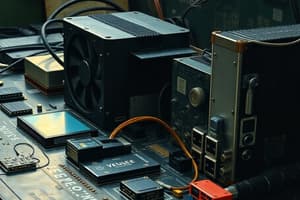Podcast
Questions and Answers
Which of the following components is considered the 'brain' of a computer?
Which of the following components is considered the 'brain' of a computer?
- Hard drive
- Motherboard
- Graphics card
- Microprocessor (correct)
What is the primary function of a modem?
What is the primary function of a modem?
- Connect computers in a local network
- Translate analog signals to digital signals (correct)
- Manage network traffic
- Serve as a firewall
Which network device can manage traffic and assign IP addresses?
Which network device can manage traffic and assign IP addresses?
- Modems
- Routers (correct)
- Switches
- Hubs
What distinguishes a gateway from a router?
What distinguishes a gateway from a router?
Which firewall type is known for inspecting the packet itself?
Which firewall type is known for inspecting the packet itself?
What is a main disadvantage of using bus topology in networking?
What is a main disadvantage of using bus topology in networking?
Which of the following is NOT a function of a firewall?
Which of the following is NOT a function of a firewall?
What is the purpose of edge-enabled devices?
What is the purpose of edge-enabled devices?
Which OSI model layer is responsible for the actual data transport?
Which OSI model layer is responsible for the actual data transport?
What type of firewall combines packet-filtering and network address translation?
What type of firewall combines packet-filtering and network address translation?
Which layer is responsible for transforming data into a format interpretable by other devices?
Which layer is responsible for transforming data into a format interpretable by other devices?
Which protocol is associated with the Transport Layer?
Which protocol is associated with the Transport Layer?
What is the primary function of the Network Layer?
What is the primary function of the Network Layer?
Which cloud computing model allows for limited management and development capabilities?
Which cloud computing model allows for limited management and development capabilities?
Which deployment model is shared among multiple organizations for a common interest?
Which deployment model is shared among multiple organizations for a common interest?
What describes the role of a Cloud Service Provider (CSP)?
What describes the role of a Cloud Service Provider (CSP)?
Which layer includes protocols for establishing communication sessions?
Which layer includes protocols for establishing communication sessions?
What is the purpose of the COSO Enterprise Risk Management framework?
What is the purpose of the COSO Enterprise Risk Management framework?
What type of network architecture is used for limited geographical areas, such as a house?
What type of network architecture is used for limited geographical areas, such as a house?
Which of the following is NOT a component of the COSO Enterprise Risk Management framework?
Which of the following is NOT a component of the COSO Enterprise Risk Management framework?
Which layer is responsible for converting a message into bits for transmission?
Which layer is responsible for converting a message into bits for transmission?
Which of the following protocols provides encryption during data transmission?
Which of the following protocols provides encryption during data transmission?
In the context of cloud computing, what does IaaS stand for?
In the context of cloud computing, what does IaaS stand for?
Flashcards
Computer Hardware
Computer Hardware
Physical parts of a computer like the motherboard, hard drive, and RAM.
End-User Devices
End-User Devices
Devices that directly interact with users, such as laptops, desktops, and tablets.
Microprocessor
Microprocessor
The brain of the computer, responsible for processing instructions.
External Peripheral Devices
External Peripheral Devices
Signup and view all the flashcards
Modem
Modem
Signup and view all the flashcards
Router
Router
Signup and view all the flashcards
Switch
Switch
Signup and view all the flashcards
Gateway
Gateway
Signup and view all the flashcards
Packet-Filtering Firewall
Packet-Filtering Firewall
Signup and view all the flashcards
OSI (Open Systems Interconnection) Model
OSI (Open Systems Interconnection) Model
Signup and view all the flashcards
Application Layer
Application Layer
Signup and view all the flashcards
Presentation Layer
Presentation Layer
Signup and view all the flashcards
Session Layer
Session Layer
Signup and view all the flashcards
Transport Layer
Transport Layer
Signup and view all the flashcards
Network Layer
Network Layer
Signup and view all the flashcards
Data Link Layer
Data Link Layer
Signup and view all the flashcards
Physical Layer
Physical Layer
Signup and view all the flashcards
Local Area Network (LAN)
Local Area Network (LAN)
Signup and view all the flashcards
Wide Area Network (WAN)
Wide Area Network (WAN)
Signup and view all the flashcards
Software-Defined WAN
Software-Defined WAN
Signup and view all the flashcards
Virtual Private Network (VPN)
Virtual Private Network (VPN)
Signup and view all the flashcards
Operating System (OS)
Operating System (OS)
Signup and view all the flashcards
Firmware
Firmware
Signup and view all the flashcards
Cloud Computing
Cloud Computing
Signup and view all the flashcards
Infrastructure as a Service (IaaS)
Infrastructure as a Service (IaaS)
Signup and view all the flashcards
Study Notes
Computer Hardware
- Consists of physical components of computers and peripherals
- Includes backend devices like switches, servers, and routers; and end-user devices like laptops, desktops, tablets, and wearables
- Internal components include the microprocessor (brain), graphics/sound cards, hard drives (permanent storage), RAM (temporary storage), motherboard (connects critical pieces), and power supply
External Peripheral Devices
- Not integrated into the machine itself
- Examples include mouse, keyboard, speakers, microphones, disk drives, memory devices, network cards, and monitors
Infrastructure Housing
- Typically data centers or offices
- Features advanced security systems, ventilation, and climate control
Network Infrastructure Hardware
- The hardware, software, layout, and topology enabling network connectivity/communication
- Includes modems, routers, switches, gateways, edge-enabled devices, servers and firewalls
Modem
- Connects a computer to the internet
- Translates analog signals to digital signals
- Provides internet access to homes/offices
- Has a public IP address
Routers
- Manage network traffic by connecting devices
- Route data packets based on source
- Assign IP addresses
- Link modems and switches
Hubs
- A primitive connection point for multiple devices
- Forwards data packets to all connected devices
Switches
- Divide a network connection into multiple connections
- Can route traffic to target destinations but cannot assign IP addresses — more advanced than a hub
Gateways
- Act as intermediaries between networks
- Convert protocols for different networks
Proxies
- Gateways that mediate but don't translate protocols
- Used to block hackers
Protocol
- Rules governing data transmission
- TCP/IP is a common internet protocol
Edge-Enabled Devices
- Enable computing/storage/networking close to data origin
- Decentralizes computing power
- Provides faster network response times
Servers
- Master coordination for computers, programs, and data in a network
- Respond to client requests with data
Signal Modifiers
- Increase signal strength
- Types include electrical, radio frequency, audio, and optical
Firewalls
- Control user access and authentication to networks
- Can be physical, software, or both
- Ensure traffic flows smoothly and prevents unauthorized access
Basic Packet-Filtering Firewalls
- Analyze network traffic packets
- Determine acceptance based on firewall storage criteria
- Allow trusted sources (IP addresses)
Circuit-Level Gateway Firewalls
- Verify packet sources against security rules
Application-Level Gateway Firewalls
- Inspect the packet content
- Resource-intensive and potentially slow
Network Address Translation (NAT) Firewalls
- Assign public IP addresses to machines on a private network (masking their identities)
Stateful Multilayer Inspection Firewalls
- Combine packet filtering and NAT functions
Next-Gen Firewalls
- Apply different firewall rules to different applications and users
Network Topology
- Physical layout of network nodes
Bus Topology
- Linear or tree-like arrangement
- Vulnerable to downtime if the central line fails
Mesh Topology
- Numerous connections between nodes
- Commonly used in wireless networks
- High traffic, costly
Ring Topology
- Nodes connected in a circular path
- Minimizes collisions but can be slow
Star Topology
- Data passes through a central hub
- Easy to identify damaged cables
OSI Model
- Developed by the International Organization for Standardization (ISO)
- Divides network functions into 7 layers
OSI Model - 7 Layers
- Application, Presentation, Session, Transport, Network, Data Link, and Physical layers
Application Layer (Layer 7)
- Interface between applications
- Includes HTTP, FTP, SMTP, and EDI
Presentation Layer (Layer 6)
- Transforms data into a format other devices can interpret (e.g. encryption, image/video formats)
- Includes ASCII, JPEG, and MPEG
Session Layer (Layer 5)
- Establishes and maintains communication sessions
- Includes SQL, RPC, and NFS
Transport Layer (Layer 4)
- Controls communication connections between devices
- Includes TCP, UDP, SSL, and TLS
Network Layer (Layer 3)
- Adds routing address headers/footers
- Includes IP, IPSec, NAT, and IGMP
Data Link Layer (Layer 2)
- Formats data packets for transmission
- Adds MAC addresses
- Includes ISDN, PPTP, L2TP, and ARP
Physical Layer (Layer 1)
- Converts messages into bits (0s and 1s) for transmission
- Includes HSSI and SONET
Common Types of Network Architecture
- LANs (Local Area Networks) cover limited geographic areas
- WANs (Wide Area Networks) cover larger areas (multiple offices/internet)
- Software-Defined WANs optimize connectivity
- VPNs provide secure remote network access
Operating Systems (OS)
- Software that controls basic computer functions (scheduling tasks, running applications, controlling peripherals)
- Includes Windows, macOS, and iOS
Firmware
- Software embedded in hardware (motherboard, microprocessor)
- Directs functions
- Typically not updated frequently
Mobile Technology
- Wireless devices connecting to the internet
- Combining hardware, software, and applications (e.g. laptops, tablets, smartphones, Wi-Fi, Bluetooth, 4G/5G)
- Can be end-user devices or network devices
Internet of Things Devices
- Devices connecting to the internet (e.g., Siri, Alexa, TVs, home automation devices)
- Typically require Bluetooth or internet connectivity
Cloud Computing
- Shared computing resources over the internet
- Renting storage space, processing power, or software
Cloud Computing Models
- IaaS (Infrastructure as a Service): Outsourced servers, storage, and networking
- PaaS (Platform as a Service): Provides tools and solutions remotely for developing applications
- SaaS (Software as a Service): Company sells applications (often with Business Process as a Service, like payroll or billing)
Cloud Computing Deployment Models
- Public, Private, Hybrid, and Community clouds
Cloud Service Provider (CSP)
- Third-party providers of cloud services
- Often have advanced skills and experience
Committee of Sponsoring Organizations (COSO)
- Develops guidance for internal control, enterprise risk management, governance, and fraud deterrence
COSO Enterprise Risk Management Framework
- SPRIG framework: Strategy & Objective Setting, Performance, Review & Revision, Information, Communication & Reporting, Governance & Culture
- Includes risk appetite identification, risk prioritization, performance review, and information management
Risks in Implementing CSP
- Competitor adoption, transparency, reliability/performance, application issues, security/compliance, vendor lock-in
- Risk increases when moving from a private to public cloud model or from SaaS to IaaS
Studying That Suits You
Use AI to generate personalized quizzes and flashcards to suit your learning preferences.




